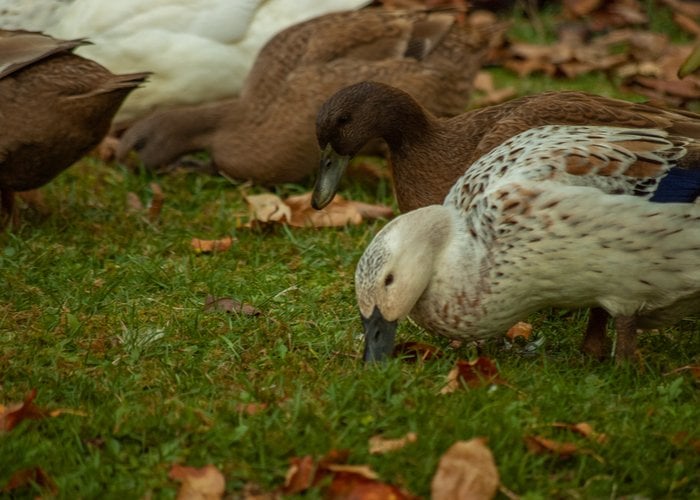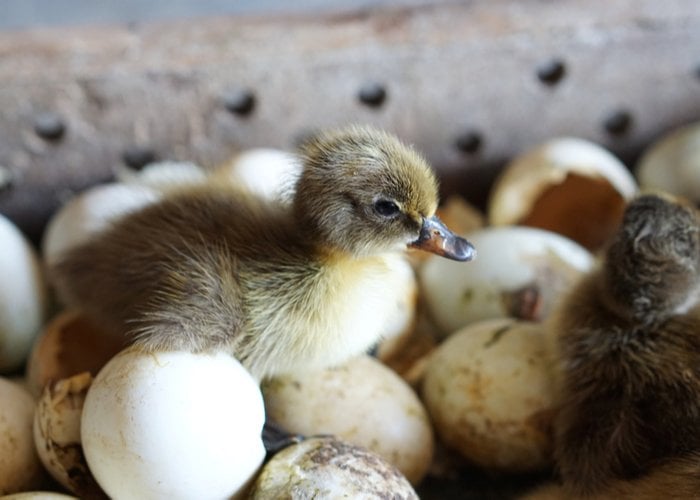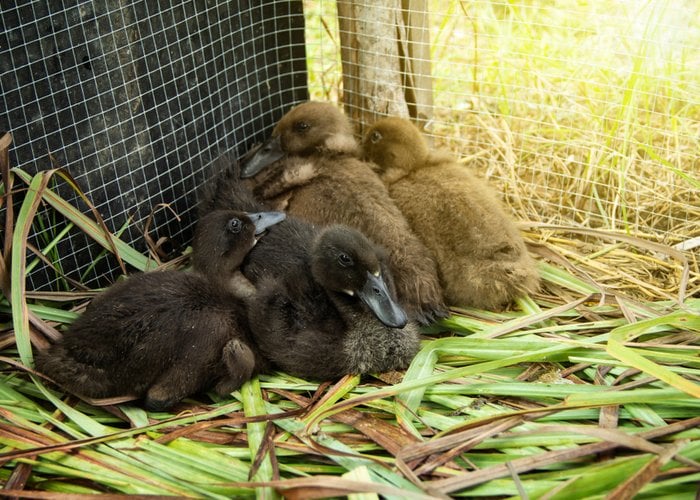Last Updated on July 2, 2021 by Fumipets
Khaki Campbell ducks are one of the most popular farmed duck breeds in America. Runner, Fawn, and Rouen ducks were crossed to produce this appealing breed. Some historical records claim Khaki Campbell ducks were crossed with wild Mallard ducks, while others claim otherwise.
They are an excellent multi-purpose duck breed for both big and small farms. Khaki Campbell ducks are outstanding egg layers as well as sitters. Because it can be successfully grown for its excellent and juicy flesh, this duck breed is generally referred to as a multi-purpose duck.

History
Khaki Campbell Ducks Have a Long History. During the late 1800s, the Khaki Campbell breed was developed in Gloucestershire, England. Adele Campbell intended to develop a duck breed that would provide her family with roasted duck on a regular basis.
Adele Campbell crossed her White Indian Runner and Fawn ducks at first because of their strong laying capabilities. Campbell then crossed the first crossing’s progeny with a Rouen duck. The goal of the second breeding was to produce ducklings with a bigger physique that approximated that of a regular meat duck.
The Campbell breed was the first duck breed to be released to the general public in 1898. Buff coloured feathers were trendy at this time, so Adele Campbell crossed her original ducks with Penciled Runner ducks to produce more stylish plumage.
Campbell was reminded of the shades of British army uniforms by the colour generated, which did not quite resemble a buff. Khaki Campbell was the name she gave to the new duck breed she produced.
The Khaki Campbell duck breed did not make its initial appearance in the United States until 1941. The American Poultry Association eventually recognised the breed. In America, the number of the Khaki Campbell breed stayed stable or dropped at first. However, the breed saw a renaissance in the 1970s, when the “back to the land” movement was adopted by tens of thousands of Americans. When a flood of Asian immigrants arrived in the United States after the Vietnam War, they took their love of duck eggs with them. Another spike in Khaki Campbell duck imports happened as a result of the breed’s strong egg-laying reputation.
Physical Characteristics
Khaki Campbell ducks look a lot like their Mallard forefathers. Their bodies are mildly khaki-colored, but their dark brown heads, which have an olive green hue to them, set them apart from the wild variety.
In addition, unlike Mallards, Khaki Campbell ducks do not have a white ring around their neck. Khaki, dark, white, and pied are the four colours available. The American Poultry Association recognises only the khaki colour of ducks.
When fully grown, members of this breed are a light to medium weight duck that weighs between four and five pounds.
Drakes have a green beak, and their legs and feet are generally a dark orange colour. The male Khaki Campbell’s lower back, upper neck, head, and tail culverts are a brown to bronze colour, while the remainder of his plumage is a moderate khaki colour.
Female Khaki Campbells have a lighter brown head, a beak that is more golden yellow in colour, and feathers that are more evenly brown in colour.
Ducklings are dark brown to black in colour, with a little bit of white plumage in the breast region, whether male or female.
This breed is very resistant to the effects of the environment. Khaki Campbell ducks have been known to thrive in cold temperatures for weeks at a time. They can also survive in hot and desert areas, when summer temperatures may reach up to 100 degrees.
Khaki Campbell ducks, like virtually other domestic duck types, are unable to fly. A duck can flap its wings sufficiently to get a few inches off the ground and push itself forward for a few feet on rare occasions, but that is the end of its flying skills.
Egg Laying
This breed’s duck hens typically lay between 170 and 230 eggs each year. During their first two years of life, the hens often lay even more eggs.
On average, Khaki Campbell hens begin laying at the age of five to seven months.
This type of duck hens may produce eggs for up to five years without diminishing in amount.
Khaki Campbell chickens lay extremely big creamy white eggs that weigh roughly two and a half to two and three quarter ounces. Some hens produce eggs that are somewhat green in colour.
A Khaki Campbell duck has an average lifespan of eight to ten years. Although egg laying slows as the chickens grow, it seldom ceases completely, and the quality of the eggs does not seem to suffer.

Personality Traits
This kind of duck is not as sociable and trusting of its caretakers as the Pekin duck breed. Khaki Campbell ducks are sluggish to warm up to new environments and human caretakers, but they rapidly blend into an established flock and eventually grow to trust the people who feed and care for them.
Campbell ducks, sometimes known as Khaki Campbells, are a rather quiet breed. When free ranging or confined, they are not prone to producing excited sounds throughout the day.
Because of their independent personality features, they make a suitable free range duck breed.
When nurtured with chickens or guinea pigs from a young age in a brooder, they tend to imprint on their companions and stay relatively inseparable for the rest of their lives.
Khaki Campbell hens don’t always have it easy when it comes to mothering. From experience, it seems that a hen of this duck breed will lay and sit the eggs with great care, but after the ducklings are born, they frequently believe their duty is done.
Dietary needs
A specialised diet is not required for Khaki Campbell ducks. When they are at least three months old, they may be given non-medicated chick starter and either waterfowl, game bird, or chicken feed. Scratch feed is not suggested for ducks owing to the risk of choking, although crumble and pellet feed kinds of chicken feed are often given to domesticated duck breeds.
Khaki Campbell ducks (as well as any other duck, chicken, or guinea breed) will need grit to help them digest their food effectively and securely if housed in a duck house or coop and run environment.
Khaki Campbell ducks can assist clear any backyard or property of slugs and other troublesome insects that may itch and sting your family or devour your garden produce since they are such active free rangers.
Khaki Campbell ducks like slugs as a snack. If they feel a slug is hidden just out of reach, they will dig in the dirt for an hour.
Coop Setup
A robust and predator-proof duck home or duck coop with clean and dry bedding and enough ventilation will keep members of this prolific egg-laying breed healthy, happy, and providing food for your morning table.
Inside the duck house run or in the daily free ranging setting, a water supply of some kind (baby pool, natural pond, or beautiful little garden pond) will be required.
A waterer that is filled and cleaned on a regular basis should always be available to the flock — and protected from freezing during the winter months. A decent ratio is one waterer for every four ducks maintained in pens. Ducks consume a lot more water than chickens and guinea pigs, therefore they should never be left without clean water for more than eight hours.

Ducklings
As with all other duck breeds, never introduce a Khaki Campbell to swimming water until it is at least three weeks to two months old. Ducklings at this age lack the natural body oils that enable them to dry rapidly and keep them from being chilly.
Because Khaki Campbell chickens have poor mothering instincts and may get broody with their eggs, you’ll probably have to incubate any eggs you wish to hatch.
A Khaki Campbell duck egg takes around 28 days to develop, either naturally or in an incubator.
Khaki Campbells are a calm and beautiful duck breed that may be raised in a duck home and run or in a free range setting. Keeping this kind of duck exclusively in a cage will not fulfil their need to hunt bugs as much as allowing them to wander in the grass for at least a few hours each day would.
Both drakes and hens are generally well-behaved with other barnyard creatures and caretakers of all ages. Although they are a self-sufficient duck breed, they may get frightened if pursued by children, leading to them being wary of their adult carers.


















